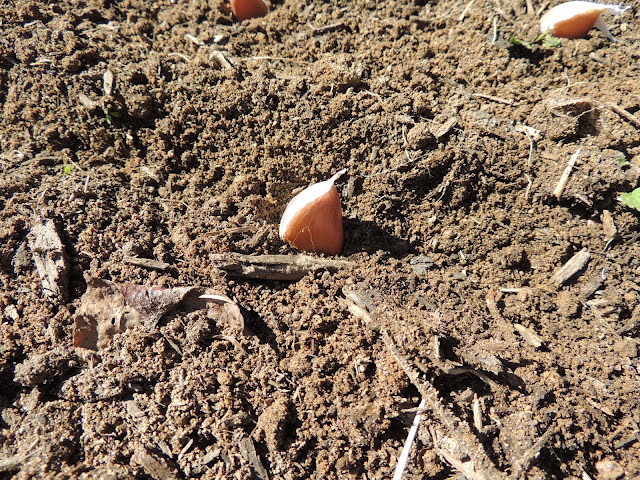If you know me well, you know I like to take classes and boy was this one worth a few hours on a Saturday afternoon. Christopher, from Red Wing Farms in Asheville helped me learn everything I needed to know to feel confident in growing garlic. And lucky for you ( and with his permission), I'm going to tell you all about it.
Even though softneck garlic has advantages, the hardneck garlic is supposed to be more flavorful than softneck and grows scapes in the spring. Scapes are the flowering part of the plant and are tasty in lots of dishes. I kept wondering why my garlic didn't have scapes last year, now I know. It was because I had planted softneck and it doesn't have scapes. This year I decided to grow some of both.
I ordered seed garlic from Filaree Garlic Farm in Washington state. I loved looking through their catalog and they were really helpful in answering questions about my growing area. I was thrilled with the quality of the seed garlic. Each head was big and healthy and ready to plant. If my garlic grows well this year, I can save some of the largest heads to plant as seed next October. That would be great, because seed garlic is expensive. But there are so many different varieties of garlic with varying flavors that I think I may just have to try something new out of that catalog for years to come.
Before planting, I had to prepare the garden bed. Doesn't that soil look nice? After about five years of working these beds and adding composted material back into them each season, the soil is happy and brimming with worms and such.
I separated the cloves, reserving the smallest ones to plant as spring garlic. They won't develop into full heads, but milder than regular garlic, they can be chopped and eaten like green onions.
If each one of these cloves grow into a full head of garlic, I'm going to have plenty for storage. I planted Kilarney Red as my hardneck variety and these will need to be eaten first when harvested in July. I planted twice as much of the softneck variety, Silver White Silverskin, and hope these grow really well, so I can make more of those cool braids to store for winter, or maybe give for Christmas gifts?
The bigger the clove, the bigger the potential head of garlic will be.
The cloves were planted like this, about 2 inches deep, and six inches apart.
After the garlic was planted and covered, I spread straw mulch over the bed. This will help maintain moisture as well as protect it from extreme freezing conditions through the winter.
Last step was giving it a good watering. And that's it. Now, I basically forget about it until summer. Some plants may send up green shoots during the winter, but when spring arrives the garlic begins it major growth spurt. The hardest thing for me about growing garlic is wanting to see what's going on under that straw...and having to wait to dig it up. I feel that way about all my root vegetables though. Growing garlic is easy. The only negative I can see, is it has to be in the ground for eight to nine months, monopolizing important garden space. But if you have the room, it's a rewarding growing experience and having your own fresh garlic is huge for this cook. This bed will probably be home for my garlic for the next few growing seasons. However, I have my eye on a space to put in a few more raised beds before spring. I am a big fan of growing food in boxes.













I really like your garden set up. It has given me ideas for future gardening. Thanks for the pics!!!
ReplyDelete